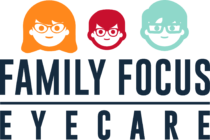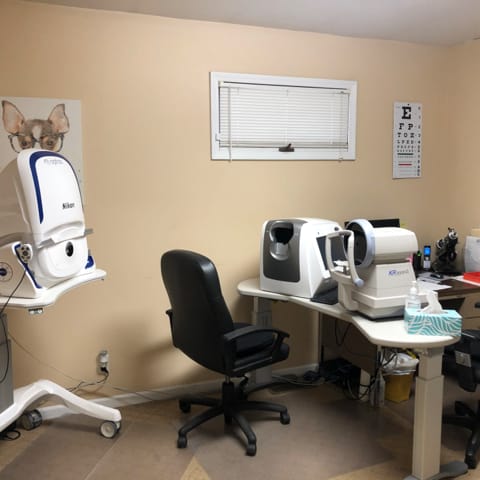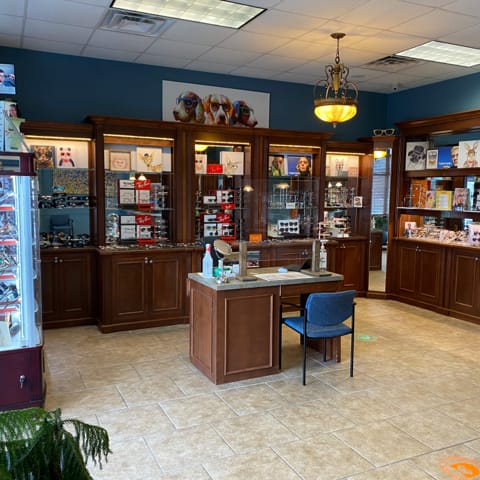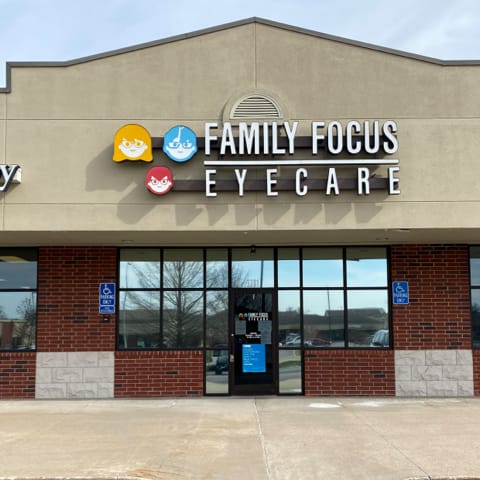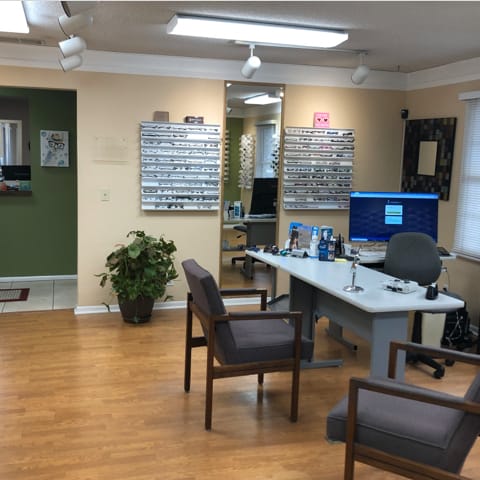Specialized Care for Myopia
Almost 30% of Americans have some degree of myopia (nearsightedness). Roughly 75% of children with myopia receive a diagnosis for the condition before the age of 12. For that reason—and many others—children should have regular, comprehensive eye exams.
If left untreated, myopia in children can continue to progress until around age 20, when vision stabilizes. But, with early intervention, we can slow the progression of myopia in children. In adults, we can manage the condition with glasses or contact lenses—or even a referral for laser eye surgery.
Family Focus Eyecare offers several methods for myopia control. Book an appointment today to learn more.

What Is Myopia?
Simply put, myopia is nearsightedness. When the eye grows too long or the cornea becomes too steep, objects in the distance will appear blurry. This is because the irregular shape of the eye causes light to focus in front of the retina rather than directly on it.
There’s no consensus about what causes myopia, but it does appear that genetics play a role. If you have myopia, there’s a chance your child might too.
More Than Just a Pair of Glasses
So your child needs glasses, what’s the big deal? Well, identifying and controlling myopia in children is about more than just correcting a refractive error. It’s about setting your child up for success in school, athletics, and life.
Vision problems can impact your child academically. Children who can’t see well at school are sometimes misdiagnosed with learning or behavioral problems like ADHD. Controlling myopia can help your child avoid learning difficulties.
Additionally, when younger children (those between 6 and 8) develop myopia, they’re more likely to develop high myopia. Those with high myopia are at a higher risk of glaucoma and continual growth and elongation of the eye can lead to retinal stretching—increasing risk of retinal detachment and other vision problems down the road.
Methods of Myopia Control
There’s no cure for myopia, but its progression can be slowed if the condition is identified in children. At Family Focus Eyecare, our staff can advise you on myopia control methods and what may be best for your child.
EyeZen Lenses
Children who spend plenty of time on digital devices or in front of screens may be at risk of developing myopia. EyeZen lenses protect against digital eye strain and help block the blue light emitted from digital screens.
Multifocal Contact Lenses
Many children can learn to wear contact lenses and tolerate them well. While single-vision lenses can correct a refractive error like nearsightedness, they don’t do much to treat the underlying problem.
Multifocal lenses contain more than one prescription in each lens. They can help slow eye growth and, in doing so, control myopia.
Corneal Refractive Therapy (CRT)
Corneal refractive therapy (CRT) is also known as orthokeratology (ortho-k). This method of myopia control uses specially-fitted contact lenses. When worn overnight, these lenses reshape the malleable cornea.
After removing these lenses in the morning, the cornea temporarily retains its new shape. The results from CRT can be maintained as long as treatment is followed.
Not only does ortho-k help to slow myopia, it corrects refractive errors at the same time.
It’s About Quality of Life
Catching a ball, flying a kite, and late-night stargazing are some of the joys of childhood. The ability to enjoy these activities, and many others, may be hindered by myopia. Please book an appointment for your child to diagnose or control their myopia today.
Visit One of Our Locations
Columbia
We are in Westbury-1.5 miles further west from our old W. Broadway location, near Toasty Goat and the new Club Carwash
- 725 S. Scott Blvd Suite 101
- Columbia, MO 65203
Our Hours
- Monday: 9:00 AM – 5:00 PM
- Tuesday: 9:00 AM – 5:00 PM
- Wednesday: 9:00 AM – 5:00 PM
- Thursday: 9:00 AM – 5:00 PM
- Friday: 9:00 AM – 5:00 PM
- Saturday: By Appointment
- Sunday: By Appointment
Eldon
Our Eldon location is on Oak Street, two blocks north of the post office and between North and High Street.
- 115 N Oak St
- Eldon, MO 65026
Our Hours
- Monday: 8:30 AM – 5:00 PM
- Tuesday: 8:30 AM – 5:00 PM
- Wednesday: 8:30 AM – 5:00 PM
- Thursday: 8:30 AM – 5:00 PM
- Friday: 8:30 AM – 5:00 PM
- Saturday: By Appointment
- Sunday: By Appointment
Our Brands
View All Brands



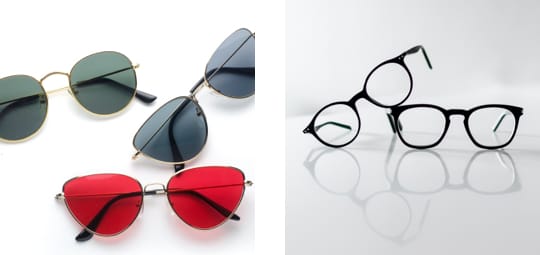

Our Testimonials
Dr. Rich is extremely helpful and thoughtful. He cleared up my eye issues within one appointment and even allowed for texts to assess after the appointment. I had been going to a specialist in Columbia for a year and they didn’t even compare to how great Family Focus Eyecare was!
Erin Scrivner
Dr. Barrett is knowledgeable, friendly and practical, I have gone to her for years and trust her. The office staff is great, they are willing to help and make appointments when you need care quickly.
Pamela Didur
The Family Focus Eyecare team is amazing! They really make you feel like home the second you walk through the door. My husband and I both have been very pleased and highly recommend them to anyone in the Columbia area!
Katie Beasley
Twice now, the staff at FFEC have gone above and beyond to help me see clearly. One time I had a contact lens come out while I was driving. It gave me a migrane, and I drove around in desperation trying to find an eye exam since my prescription was expired…. After being turned away in an EMPTY waiting room at the WalMart vision center, and not even being offered a sample pair till an an appointment could be set… I called FFEC and they not only had me come right over, they squeezed me in between two clients, gave me replacement contacts, and informed me my insurance would cover everything because they looked up my plan details for me!! (I didnt even know I had vision coverage). What an exceptional team and business!!!! I was so thankful. This might be the first review I have ever taken the time to write.
Dorian Brownlee
I had a great experience!! Very knowledgeable staff and excited about the new contact lens options! Highly recommend!
Rhonda Bledsoe
Dr. Rich was so great with our 3 year old son! He was patient and sweet. This was during COVID and they were very careful with masks and cleaning. I plan to go back myself and so does my husband.
Amanda Fisher
I had an acute eye problem and FFE was able to get me in within a few days where other places were months out. They diagnosed the problem quickly and I was on my way feeling relieved that I would soon be headache free.
Kasie Sly
The entire team was friendly, efficient and helpful throughout my entire experience. Best customer service experience I’ve had with an eye doctor in Columbia. I would highly recommend them to anyone.
Sarah Carnes
Best of the best! Very quick and courteous. No wasted time and the prices seem very fair for the services rendered. One of my biggest concerns was picking frames and they made it painless. Very pleased, I recommend them without hesitation!
Steve Baumann
Dr. Rich is by far the best eye doctor I have ever met! They went above and beyond to help me find the right pair of frames for me. I get compliments every time I wear them. No matter where I live I will always see Dr Rich for my eye care. I moved to STL and I still make the 2 hour drive to meet with him – totally worth it.
Walter Juarez
Dr. Rich is fantastic! My last eye exam has been years ago and this is my first visit at Family Focus Eyecare. I was immediately impressed with the attentive staff as you walk in, not only were the friendly but also extremely efficient getting me started and keeping me on time. The lobby area is pleasant and has a nice new feel to it. Because this was my first visit I had to go through the typical tests for them to examine my eyes and their technology & equipment are top-notch, it was so easy. Once I met with Dr. Rich he explained everything clearly and especially took the time to ask me many questions about my eyes, habits, difficulties and things I felt needed his attention. After consulting with him thoroughly and running numerous tests I was given a LOWER prescription! He was able to determine my contacts were too strong and what was causing my vision to not be perfect. Everything about my experience was perfect and I highly recommend Dr. Rich and Family Focus Eyecare!
John Sorensen
The staff is so friendly, helpful and very accommodating for kids. My girls are sad that they only get to go once a year.
Joy Lowe

Our Google Reviews

Our Blog
Does Castor Oil Remove Age Spots?
Dry EyeIPLCastor oil can help lighten age spots, but it’s not the most effective. Learn how IPL therapy can effectively remove age spots with Family Focus Eyecare. […]
Does Screen Time Cause Myopia?
Eye careMyopiaA child with large round glasses sitting on a couch and holding a smartphone very close to his face
[…]
Is Hyaluronic Acid Good for Rosacea?
AestheticsDermatologists often recommend HA to treat rosacea because it can provide moisture for parched skin and, when used as part of a customized skincare routine, may improve your complexion. […]
Does Castor Oil Remove Age Spots?

Castor oil can help lighten age spots, but it’s not the most effective. Learn how IPL therapy can effectively remove age spots with Family Focus Eyecare. […]
Does Screen Time Cause Myopia?

A child with large round glasses sitting on a couch and holding a smartphone very close to his face
[…]
Is Hyaluronic Acid Good for Rosacea?

Dermatologists often recommend HA to treat rosacea because it can provide moisture for parched skin and, when used as part of a customized skincare routine, may improve your complexion. […]
